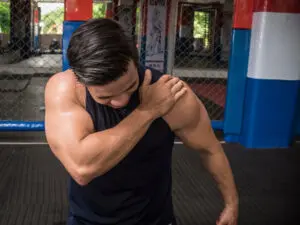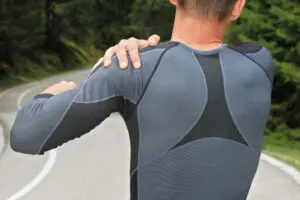A SLAP tear is an acronym describing a labral tear or lesion of cartilage in the inner portion of the shoulder joint. It means Superior Labral tear from Anterior to Posterior. The labrum is an integral part of the shoulder and a tear affects your full range of motion, especially overhead motion, which can lead to significant pain and limited movement.
The All Important Shoulder Labrum
The shoulder labrum is a ring of cartilage that sits between the shoulder socket (glenoid) and the upper arm bone (humerus). The labrum provides needed cushion and allows the full range of motion between the two bones.
A SLAP tear can occur over time due to age, sudden trauma, or certain repetitive motions. Similar to other kinds of shoulder injuries, it can also happen in a car accident, if you fall on an outstretched arm, a dislocation, or forceful movement of the arm above shoulder level. If a tear occurs, it is painful and obstructs movement of the shoulder joint.
Type 1 SLAP Tear
This type of tear describes fraying at the top of the cartilage, but leaves the labrum attached to the glenoid. It usually occurs as one ages and is found frequently in middle aged and older adults.
Sometimes there may be little to no symptoms experienced by the patient from a type 1 SLAP tear. This injury can normally be treated without surgery, and can be managed using over-the-counter anti-inflammatory medications and perhaps physical therapy.
Type 2 SLAP Tear
This is the most common type of tear to the shoulder labrum. In this situation, the labrum and bicep tendon do detach from the glenoid and result in a dislocated shoulder. This can occur either to the anterior or posterior sides.
In most cases, Type 2 is treated by Dr. Samuel Koo with arthroscopic surgery.
Type 3 SLAP Tear
With a type 3 SLAP tear, the labrum collapses into the shoulder joint, while the bicep tendon remains in place. This particular injury is also commonly referred to as a bucket-handle tear due to the appearance of the labrum once it has detached and begun to droop.
Treatment options for a type 3 SLAP tear include arthroscopic surgery to remove the collapsed segment and repair any other unstable portions of the shoulder.
Type 4 SLAP Tear
Type 4 is similar to the above type 3, except that the collapsed labrum has not fully detached. Instead, the labrum hangs down and extends into the bicep tendon, which often causes symptoms of popping or locking within the shoulder joint.
Treatment can vary depending on how extensive the damage to the bicep tendon is, as the tendon may require repair in addition to the torn labrum.
Typical Treatment Protocols for SLAP Tears
Typically, these tears are treated conservatively with anti-inflammatory medications. Physical therapy may also be recommended to improve the patient’s range of motion and flexibility.
If these solutions are not sufficient in reducing the patient’s pain or increasing their shoulder strength, surgery may be recommended. Dr. Samuel Koo will often perform arthroscopic surgery to either remove the torn parts of the labrum, or reattach the torn parts using sutures. Patients will need to remain in a sling for 2 – 6 weeks following surgery and then attend regular physical therapy sessions.
The specific course of treatment is based on the type of SLAP tear, the patient’s age, and their level of activity. No two cases are exactly alike, and so it is best to discuss your options with Dr. Samuel Koo when looking to repair an injury of the shoulder. Call (425) 823-4000 to schedule an appointment today.




